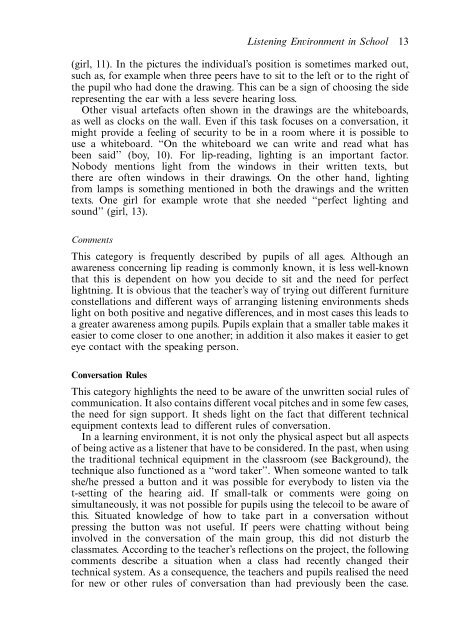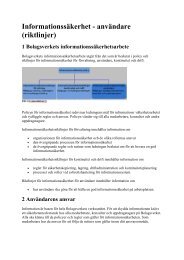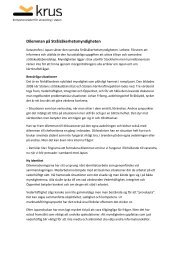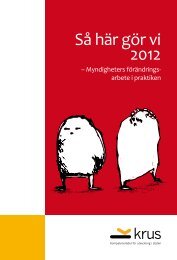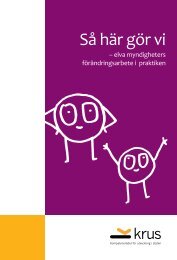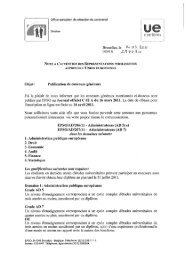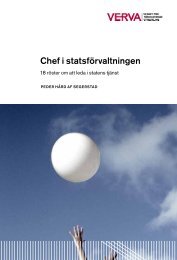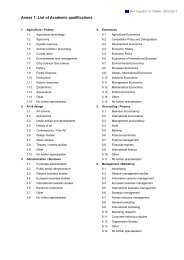Dialogkompetens i skolans vardag - Publikationer - LTU - Luleå ...
Dialogkompetens i skolans vardag - Publikationer - LTU - Luleå ...
Dialogkompetens i skolans vardag - Publikationer - LTU - Luleå ...
You also want an ePaper? Increase the reach of your titles
YUMPU automatically turns print PDFs into web optimized ePapers that Google loves.
Listening Environment in School 13<br />
(girl, 11). In the pictures the individual’s position is sometimes marked out,<br />
such as, for example when three peers have to sit to the left or to the right of<br />
the pupil who had done the drawing. This can be a sign of choosing the side<br />
representing the ear with a less severe hearing loss.<br />
Other visual artefacts often shown in the drawings are the whiteboards,<br />
as well as clocks on the wall. Even if this task focuses on a conversation, it<br />
might provide a feeling of security to be in a room where it is possible to<br />
use a whiteboard. ‘‘On the whiteboard we can write and read what has<br />
been said’’ (boy, 10). For lip-reading, lighting is an important factor.<br />
Nobody mentions light from the windows in their written texts, but<br />
there are often windows in their drawings. On the other hand, lighting<br />
from lamps is something mentioned in both the drawings and the written<br />
texts. One girl for example wrote that she needed ‘‘perfect lighting and<br />
sound’’ (girl, 13).<br />
Comments<br />
This category is frequently described by pupils of all ages. Although an<br />
awareness concerning lip reading is commonly known, it is less well-known<br />
that this is dependent on how you decide to sit and the need for perfect<br />
lightning. It is obvious that the teacher’s way of trying out different furniture<br />
constellations and different ways of arranging listening environments sheds<br />
light on both positive and negative differences, and in most cases this leads to<br />
a greater awareness among pupils. Pupils explain that a smaller table makes it<br />
easier to come closer to one another; in addition it also makes it easier to get<br />
eye contact with the speaking person.<br />
Conversation Rules<br />
This category highlights the need to be aware of the unwritten social rules of<br />
communication. It also contains different vocal pitches and in some few cases,<br />
the need for sign support. It sheds light on the fact that different technical<br />
equipment contexts lead to different rules of conversation.<br />
In a learning environment, it is not only the physical aspect but all aspects<br />
of being active as a listener that have to be considered. In the past, when using<br />
the traditional technical equipment in the classroom (see Background), the<br />
technique also functioned as a ‘‘word taker’’. When someone wanted to talk<br />
she/he pressed a button and it was possible for everybody to listen via the<br />
t-setting of the hearing aid. If small-talk or comments were going on<br />
simultaneously, it was not possible for pupils using the telecoil to be aware of<br />
this. Situated knowledge of how to take part in a conversation without<br />
pressing the button was not useful. If peers were chatting without being<br />
involved in the conversation of the main group, this did not disturb the<br />
classmates. According to the teacher’s reflections on the project, the following<br />
comments describe a situation when a class had recently changed their<br />
technical system. As a consequence, the teachers and pupils realised the need<br />
for new or other rules of conversation than had previously been the case.


